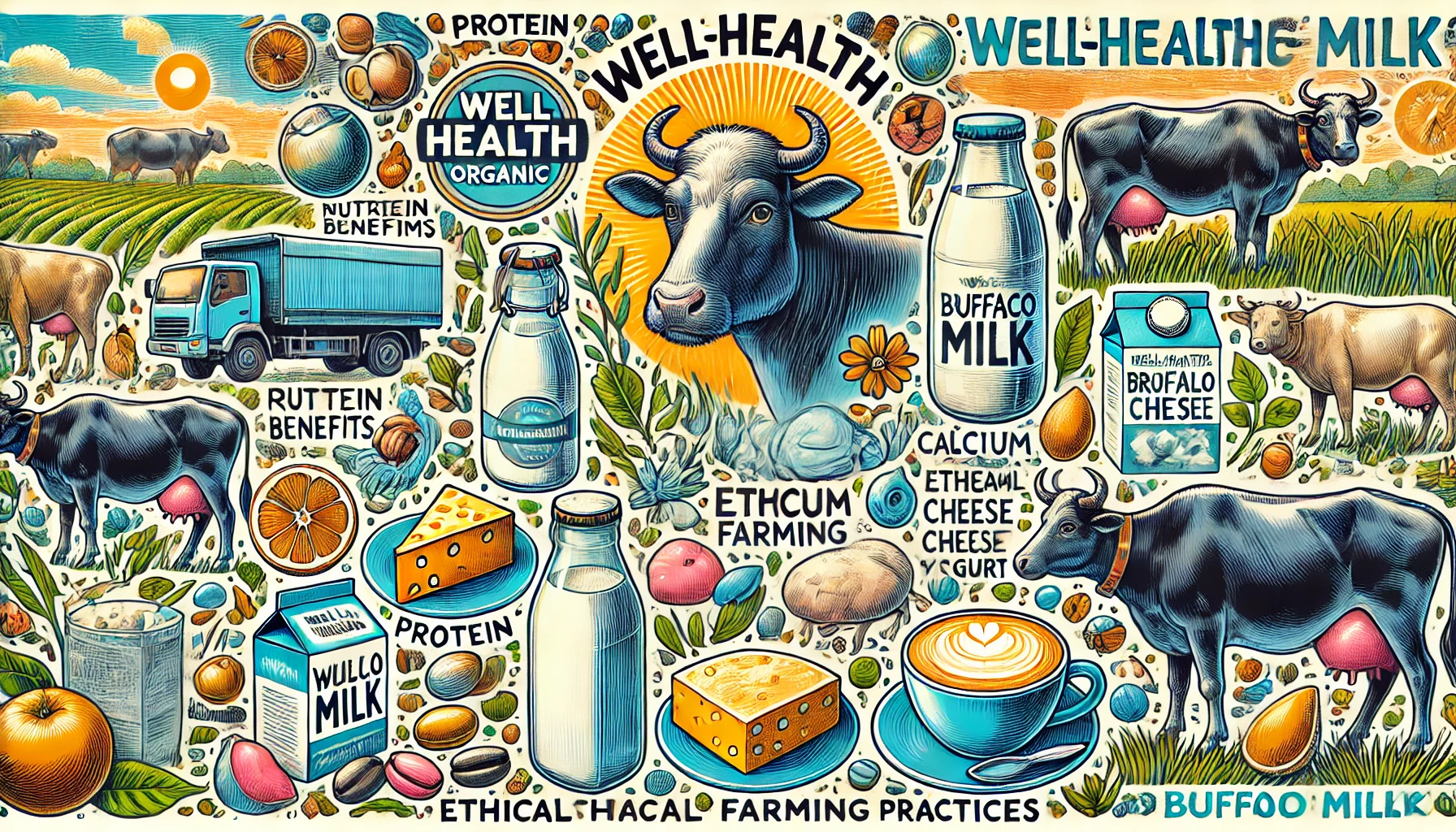
WellHealthOrganic Buffalo Milk is a standout choice for health-conscious individuals seeking nutritious and delicious alternatives. Known for its rich nutritional profile, it offers higher protein, calcium, and essential vitamins and minerals. Produced through sustainable and ethical farming practices, this milk not only supports your health but also promotes environmental responsibility. With its unique taste and versatility in culinary applications, WellHealthOrganic Buffalo Milk is an excellent addition to any diet. Read on to discover its numerous benefits, practical uses, and why it outshines other milk options.
Nutritional Profile
Protein, Calcium, and Other Vital Nutrients
WellHealthOrganic Buffalo Milk is a powerhouse of nutrition, providing higher levels of protein and calcium compared to regular cow’s milk. This makes it an excellent choice for those looking to increase their intake of these essential nutrients. Protein is crucial for muscle repair and growth, while calcium is vital for strong bones and teeth. Additionally, buffalo milk is rich in other vital nutrients such as magnesium, potassium, and phosphorus, all of which contribute to overall health and well-being.

Vitamins and Minerals
Buffalo milk is loaded with vitamins that play a significant role in maintaining good health. It contains higher amounts of Vitamin A, which is essential for vision and immune function. The presence of Vitamin D in buffalo milk helps in calcium absorption, supporting bone health. Moreover, it provides a good amount of B vitamins, including B2 (riboflavin) and B12, which are important for energy production and red blood cell formation.
Higher Fat Content
One of the distinguishing features of buffalo milk is its higher fat content. This makes the milk creamier and richer in taste, which can enhance the flavor of various dishes. The higher fat content also means that buffalo milk provides more energy per serving, making it a good option for those needing additional calories. The fat in buffalo milk includes healthy fats that can support brain function and provide long-lasting energy.
Health Benefits
Boosts Immunity
Buffalo milk is rich in essential nutrients that can significantly enhance the immune system. It contains high levels of Vitamin A and zinc, both of which play crucial roles in supporting immune function. Vitamin A helps maintain the integrity of skin and mucous membranes, which act as barriers against infections. Zinc is vital for the development and function of immune cells, ensuring the body can effectively respond to pathogens.
Bone Health
The high calcium content in buffalo milk makes it an excellent choice for maintaining and improving bone health. Calcium is necessary for the development and maintenance of strong bones and teeth. Regular consumption of buffalo milk can help prevent osteoporosis and other bone-related conditions, especially in populations at risk, such as the elderly and postmenopausal women. Additionally, the presence of Vitamin D in buffalo milk aids in calcium absorption, further supporting bone density and strength.
Cardiovascular Health
Buffalo milk contains healthy fats that can benefit cardiovascular health. It has a higher proportion of monounsaturated and polyunsaturated fats, which are known to support heart health by reducing bad cholesterol levels and increasing good cholesterol levels. The presence of potassium in buffalo milk also contributes to heart health by helping to maintain normal blood pressure levels. Regular intake of buffalo milk can thus support overall cardiovascular function and reduce the risk of heart disease.
Skin Health
The rich content of antioxidants, such as Vitamin E and selenium, in buffalo milk is beneficial for skin health. These antioxidants help combat oxidative stress, which can cause premature aging and skin damage. Vitamin A in buffalo milk also promotes skin cell renewal and repair, ensuring a healthy and vibrant complexion. Including buffalo milk in the diet can lead to healthier, more radiant skin.
Ethical Sourcing and Production
Organic Certification
WellHealthOrganic Buffalo Milk is produced under strict organic farming guidelines, which prohibit the use of synthetic pesticides, fertilizers, and genetically modified organisms (GMOs). The organic certification ensures that the buffaloes are raised in a natural environment, fed organic feed, and are not treated with antibiotics or growth hormones. This not only enhances the quality of the milk but also supports animal welfare and environmental sustainability.
Sustainable and Ethical Farming Practices
The production of WellHealthOrganic Buffalo Milk emphasizes sustainable and ethical farming practices. Farmers use eco-friendly methods to reduce the environmental impact, such as water conservation, soil health improvement, and renewable energy sources. These practices help maintain the natural ecosystem and promote biodiversity.
Buffaloes are raised in humane conditions, with adequate space to graze and roam freely. This humane treatment contributes to the health and well-being of the animals, resulting in higher quality milk. Ethical practices also include fair wages and safe working conditions for farm workers, ensuring a positive impact on local communities.
Transparency in Production
Transparency is a key aspect of WellHealthOrganic’s production process. Consumers are provided with detailed information about the sourcing and production of the milk, including the farms where the buffaloes are raised and the methods used in milk extraction and processing. This transparency builds trust and allows consumers to make informed choices about the products they consume.
Environmental Responsibility
WellHealthOrganic is committed to minimizing its carbon footprint. The production process includes measures to reduce greenhouse gas emissions and waste. Recycling and composting programs are implemented to manage farm waste effectively. The use of renewable energy sources, such as solar and wind power, further reduces environmental impact.
Community Engagement
WellHealthOrganic supports local communities through various initiatives. By partnering with small-scale farmers, the company helps improve their livelihoods and provides training on sustainable farming practices. Community engagement programs also focus on education and health, contributing to the overall well-being of the areas where the farms are located.
Comparisons with Other Milks
Buffalo Milk vs. Cow Milk
Buffalo milk and cow milk are two popular dairy options, each with distinct characteristics. Buffalo milk contains higher levels of fat, which contributes to its creamier texture and richer taste. This makes it ideal for producing dairy products like cheese, butter, and yogurt. In terms of nutritional content, buffalo milk generally offers more protein, calcium, and vitamins A and D compared to cow milk. This can be beneficial for those seeking to increase their intake of these essential nutrients.

Cow milk, on the other hand, is lighter and more widely consumed globally. It is often preferred for drinking and in recipes that require a less dense dairy product. While cow milk is lower in fat and calories, it still provides significant nutritional benefits, including good amounts of protein, calcium, and B vitamins.
Buffalo Milk vs. Plant-Based Milks
Plant-based milks, such as almond, soy, and oat milk, are popular alternatives to animal milk. These options are suitable for those with lactose intolerance or those following vegan diets. Plant-based milks vary widely in their nutritional profiles. For example, almond milk is low in calories and fat but also low in protein. Soy milk, on the other hand, is higher in protein and often fortified with vitamins and minerals to make it nutritionally comparable to animal milk.
In comparison, buffalo milk is naturally rich in protein, calcium, and healthy fats without the need for fortification. It also has a more complex and richer flavor profile, which can enhance the taste of various dishes. While plant-based milks offer benefits like lower calorie content and no cholesterol, buffalo milk provides a more complete nutritional profile naturally.
Digestibility and Allergies
Digestibility is an important factor when comparing different types of milk. Buffalo milk contains less cholesterol and is easier to digest for some people due to its higher peroxidase activity, which helps break down fats more efficiently. However, both buffalo and cow milk contain lactose, which can be problematic for those with lactose intolerance. In contrast, plant-based milks are lactose-free and can be a better option for those with lactose sensitivity.
Allergies to cow milk protein can extend to buffalo milk since they share similar protein structures. Those with dairy allergies may need to avoid both types and opt for plant-based alternatives. However, buffalo milk may be less allergenic for some individuals due to differences in the casein protein content.
Taste and Texture Differences
The taste and texture of milk can significantly influence preference. Buffalo milk’s higher fat content gives it a richer, creamier texture and a slightly sweeter taste compared to cow milk. This makes it particularly suited for making thick, luscious dairy products and decadent beverages. Cow milk has a lighter, more refreshing taste, which some people prefer for direct consumption or in lighter recipes.
Plant-based milks also have varying tastes and textures depending on their source. Almond milk has a nutty flavor and a thin consistency, while soy milk has a creamier texture similar to cow milk. Oat milk offers a neutral taste and a thicker texture, making it a versatile choice for both drinking and cooking.
Uses of Buffalo Milk
Cooking and Baking
Buffalo milk’s rich and creamy texture makes it an excellent ingredient for cooking and baking. Its higher fat content provides a luxurious mouthfeel and enhances the flavor of dishes. Use it to make creamy soups, sauces, and gravies. In baking, buffalo milk can replace regular milk to create moist and tender cakes, muffins, and bread. The milk’s natural sweetness and richness also make it perfect for custards, puddings, and other desserts.
Beverages
Buffalo milk can be used to create a variety of delicious beverages. It is ideal for making thick and creamy milkshakes and smoothies. Its richness also complements coffee and tea, adding a smooth and velvety texture. Try using buffalo milk in your morning latte or cappuccino for a more indulgent experience. Additionally, buffalo milk can be used to make traditional drinks such as lassi, a popular yogurt-based drink in India.
Cheese and Yogurt Making
Buffalo milk is prized for cheese and yogurt making due to its high protein and fat content. It produces cheese with a rich, creamy texture and distinct flavor. Mozzarella di Bufala, made from buffalo milk, is a famous example, known for its soft, stretchy texture and delicate taste. Buffalo milk yogurt is thicker and creamier than regular yogurt, making it a satisfying option for breakfast or snacks. Use it as a base for parfaits, smoothies, or enjoy it plain with a drizzle of honey.
Traditional Dishes
Buffalo milk is a key ingredient in many traditional dishes across various cultures. In India, it is used to make paneer, a type of fresh cheese that is a staple in many vegetarian dishes. It is also used in making ghee, a type of clarified butter used in Indian cooking. In Italy, buffalo milk is essential for making authentic mozzarella and ricotta cheese. These traditional uses highlight the versatility and cultural significance of buffalo milk.
Desserts
The richness of buffalo milk makes it an excellent choice for desserts. Use it to make creamy ice cream, gelato, and custards. Its natural sweetness enhances the flavor of these treats, providing a more decadent experience. Buffalo milk can also be used to make traditional desserts like kulfi, a popular frozen dairy dessert in India, and panna cotta, an Italian classic.
Recipes with Buffalo Milk
Traditional and Modern Recipes
Buffalo milk’s rich texture and flavor make it ideal for a wide range of culinary creations. In traditional recipes, it is often used to make paneer, a type of fresh cheese that is a staple in Indian cuisine. To make paneer, simply boil buffalo milk, add a souring agent like lemon juice or vinegar, and strain the curds. The result is a soft, crumbly cheese that can be used in a variety of dishes.

Modern recipes also benefit from the creamy texture of buffalo milk. For instance, buffalo milk can be used to create a luxurious béchamel sauce, perfect for lasagnas and other pasta dishes. Its high-fat content ensures a silky, smooth sauce that enhances any meal.
Smoothies and Lattes
Buffalo milk can elevate your smoothies and lattes with its creamy consistency. For a nutritious smoothie, blend buffalo milk with fruits like bananas, berries, and a handful of spinach. The richness of the milk adds depth to the flavor and a smooth texture.
In lattes, buffalo milk froths beautifully, making it a great alternative to cow’s milk. Its natural sweetness pairs well with coffee, resulting in a richer, more indulgent beverage. Try it in your morning latte or a refreshing iced coffee.
Desserts
Buffalo milk shines in dessert recipes, offering a creamier texture and richer taste. For a simple yet delicious dessert, make buffalo milk rice pudding. Cook rice in buffalo milk with sugar and a pinch of cardamom, then garnish with nuts and raisins.
Another delightful treat is buffalo milk ice cream. Mix buffalo milk with sugar, cream, and your favorite flavorings, then churn it in an ice cream maker. The high-fat content of buffalo milk ensures a smooth, creamy ice cream that rivals any store-bought version.
Baked Goods
In baking, buffalo milk can replace regular milk to add richness and moisture to your recipes. Use it in cakes, muffins, and bread for a more tender crumb. For example, try a buffalo milk chocolate cake. The milk’s creamy texture enhances the chocolate flavor, resulting in a decadent dessert.
Buffalo milk can also be used in savory baked goods. In bread recipes, it creates a softer, fluffier loaf. The extra protein and fat content help the dough rise better and develop a beautiful crust.
Cheese and Yogurt
Making cheese and yogurt at home with buffalo milk is rewarding and straightforward. For homemade mozzarella, heat buffalo milk, add rennet, and stretch the curds until they are smooth and elastic. The result is a fresh, creamy cheese perfect for pizzas and salads.
Buffalo milk yogurt is another easy-to-make dairy product. Heat the milk, add a yogurt starter, and let it ferment overnight. The result is a thick, creamy yogurt that can be enjoyed plain, with fruit, or as a base for dips and sauces.
Conclusion
WellHealthOrganic Buffalo Milk stands out as a nutritious and versatile choice for a wide range of culinary and dietary needs. With its rich protein, calcium, and vitamin content, it supports health in multiple ways, from boosting immunity to enhancing bone health. The ethical sourcing and sustainable farming practices ensure that each glass of buffalo milk is both high-quality and environmentally friendly. Its unique taste and creamy texture make it ideal for various uses, from traditional recipes to modern culinary innovations. Whether enjoyed in beverages, desserts, or as a part of daily meals, WellHealthOrganic Buffalo Milk offers a delicious and healthful addition to any diet.
FAQs
1. What makes WellHealthOrganic Buffalo Milk different from cow milk?
WellHealthOrganic Buffalo Milk has a higher fat and protein content than cow milk, giving it a creamier texture and richer taste. It also contains more calcium and vitamins A and D, making it a more nutritious option.
2. Is buffalo milk suitable for people with lactose intolerance?
Buffalo milk contains lactose, so it may not be suitable for those with lactose intolerance. However, it is often easier to digest due to its lower cholesterol and higher peroxidase activity compared to cow milk.
3. How can I use buffalo milk in my daily diet?
Buffalo milk can be used in a variety of ways, including in cooking, baking, making beverages, and creating dairy products like cheese and yogurt. Its rich texture enhances the flavor and quality of dishes.
4. What are the benefits of choosing WellHealthOrganic Buffalo Milk?
Choosing WellHealthOrganic Buffalo Milk supports ethical and sustainable farming practices. The milk is produced organically, without synthetic pesticides or GMOs, ensuring a healthier product for you and a positive impact on the environment.
5. Where can I purchase WellHealthOrganic Buffalo Milk?
WellHealthOrganic Buffalo Milk is available in select stores and online. Check the company’s website or contact customer service for information on the nearest retailers or online purchase options.









